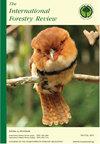What Does Brazil Know about the Origin and Uses of Tree Species Employed in the Housing Sector? Perspectives on Available Species, Origin and Current Challenges
IF 0.9
4区 农林科学
Q2 FORESTRY
引用次数: 6
Abstract
HIGHLIGHTS Outcomes with low margins of error are useful for the development of strong forest policies. Native origin timber remains a complex issue and requires efforts to improve clarity. Native timber comprises a significant part of the timber housing sector in Brazil. Exotic timber is used widely throughout the domestic construction industry. In terms of timber housing in Brazil, eucalypt wood is less used than pine. SUMMARY Timber consumption is a complex discussion for the industry, in part because the issue has been marked by doubts about lineage and origin. This paper aimed to identify challenges related to species, origins and wood use in the Brazilian construction sector. Searches on corporate websites and face-to-face interviews were used to identify involvement by species and origin in the domestic production of timber for housing. Relevant results were obtained for both methods since their margins of error were low. Forty exotic and nine native species were revealed to contribute significantly to the construction sector. ‘Grapia’ and ‘Angelim pedra’ native woods and eight eucalypt and pine species were shown to be the most popular through both methodologies. Pine timber was found to be in greater demand than that of Eucalyptus species. Despite some lack of clarity relating to the origin of certain species, the sector’s status was better than expected. However, it still requires assertive actions to increase the use of legalized wood in order to favour product certification and integration into foreign markets.巴西对住房部门所用树种的起源和用途了解多少?对现有物种、起源和当前挑战的展望
亮点误差幅度低的成果有助于制定强有力的森林政策。原生木材仍然是一个复杂的问题,需要努力提高清晰度。本土木材在巴西木材住房部门占很大一部分。异国情调的木材在整个国内建筑业中被广泛使用。就巴西的木材住房而言,桉树的使用量比松树少。木材消费对该行业来说是一个复杂的讨论,部分原因是这个问题的特点是对血统和原产地的怀疑。本文旨在确定巴西建筑业中与物种、起源和木材使用有关的挑战。在公司网站上搜索和面对面访谈被用来确定按物种和原产地参与国内住房木材生产的情况。这两种方法都获得了相关结果,因为它们的误差幅度很低。40种外来物种和9种本土物种对建筑业做出了重大贡献Grapia和Angelim pedra原生木材以及八种桉树和松树通过这两种方法被证明是最受欢迎的。松树的需求量大于桉树。尽管在某些物种的起源方面缺乏明确性,但该部门的状况好于预期。然而,它仍然需要采取果断行动,增加合法木材的使用,以促进产品认证和融入外国市场。
本文章由计算机程序翻译,如有差异,请以英文原文为准。
求助全文
约1分钟内获得全文
求助全文
来源期刊

International Forestry Review
农林科学-林学
CiteScore
2.50
自引率
6.20%
发文量
29
审稿时长
>36 weeks
期刊介绍:
The International Forestry Review is a peer-reviewed scholarly journal that publishes original research and review papers on forest policy and science, with an emphasis on issues of transnational significance. It is published four times per year, in March, June, September and December. Special Issues are a regular feature and attract a wide audience. Click here for subscription details.
 求助内容:
求助内容: 应助结果提醒方式:
应助结果提醒方式:


